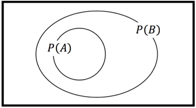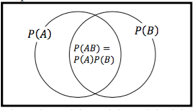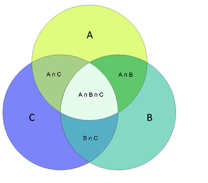General Rules in Probability
1.Complement Rule

The probability of the complement of A is
2. Conditional probability rule
The conditional probability of some event given some event is written and refers to the ratio between the area of the intersection and the area of event .
3. Union rule
The probability of a union of events can be expressed in terms of the probabilities of the events and their intersection
4. Product rule
Corresponding to the conditional probability rule, the probability of an intersection, also called a joint probability, can be expressed as
5. Sum Rule
The probability of any event A is equal to the sum of the joint probabilities of that event and any two complementary events.
6. Subset Rules

We say that A is a subset of B, written as , when the occurrence of event A indicates the occurrence of event B. Properties:
- P(A \cup B) = P(B)
- P(A \cap B) = P(A)
- P(A) \leq P(B)
- P(B \cap \bar{A}) = P(B) - P(A)
- P(A|B) = \frac{P(A)}{P(B)}
- P(B|A) = 1
7. Independence Rule
Two events A and B are independent if the probability of B does not depend on A. If A and B are independent, then;
8. Mutually Exclusive Rule (Disjoint)

A and B are two mutually exclusive events. The occurrence of event B indicates that the occurrence of A is impossible.
9. Inclusion-Exclusion Rule

In general, 𝑃(𝐴 ∪ 𝐵) = 𝑃(𝐴) + 𝑃(𝐵) − 𝑃(𝐴𝐵) From the venn diagram in the left, we can see that summing of P(A) and P(B) will count P(A ∩ B) twice and thus we need to subtract one P(A ∩ B) from their sum. Note: Mutually exclusive events is a special case for inclusion-exclusion rule. Since for mutually exclusive events

10. De Morgan’s Law
| Union | Intersection | |
|---|---|---|
| 2 | ||
| 3 | ||
De Morgan’s Law describes the effect of complement on the relationship between two events with sets operation.
- Properties:
- The complement of the union of two sets is the same as the intersection of their complements.
- The complement of the intersection of two sets is the same as the union of their complements.
11.General rules for 3 or more events

- a) Inclusion-Exclusion Rule
b) Partitions
c) Complement
d) Independence Three events A, B and C are independent if they are both mutually independent and pairwise independence. The following set of statements are sufficient to prove event A, B and C are mutually independent.